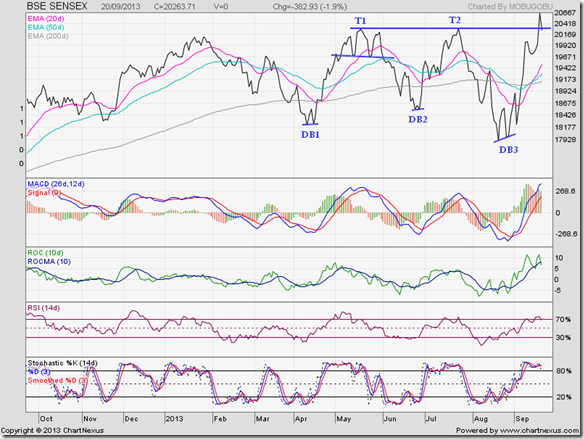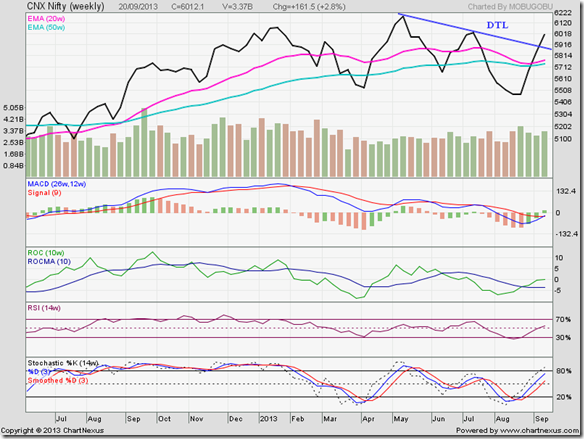There was an anti-climax and a negative shock for the Indian stock market last week. The much-awaited QE3 ‘tapering’ announcement by the US Fed turned out to be a non-event. Status quo was maintained as the economic recovery in the US remained anaemic. Global markets rejoiced that the environment of easy and cheap liquidity would continue, and many rose to new highs.
RBI ‘s announcement of a 25 bps (0.25%) repo rate hike poured cold water on the ardour of enthusiastic bulls. With WPI and CPI inflation creeping up again, RBI’s move was logical but unexpected. Bears used the opportunity to reassert themselves, leaving small investors confused about what to do next.
What are the chart patterns of Sensex and Nifty indicating after the violent gyrations in the week gone by? Is this a good time to buy, sell or stay put? To remove some of the ‘noise’ associated with bar charts, let us take a look at the closing charts of the two indices.
BSE Sensex index chart
The 1 yr closing chart pattern of Sensex shows several technical patterns that may be of interest to traders as well as investors. The corrective move from Jan – Apr ‘13 terminated with a double-bottom reversal pattern (marked DB1) at about 18220. Sensex rose to touch a closing high of 20286 in May ‘13 (marked T1), but formed a head-and-shoulders reversal pattern, and started correcting again.
A second double-bottom reversal pattern (marked DB2) formed at about 18550 in Jun ‘13 – more than meeting the downside target of the head-and-shoulders pattern at T1. The subsequent rally took the Sensex to a closing high of 20302 in Jul ‘13 (marked T2) – forming a larger double-top reversal pattern.
The double-top pattern was technically confirmed when Sensex dropped below the ‘valley’ level of DB2. The downward target from the double-top pattern (T2 – DB2 = 1750; DB2 – 1750 = 16800) was not met, as the Sensex formed a third double-bottom reversal pattern (marked DB3) at about 17900 in Aug ‘13. Note that technical analysis is not a science, and arithmetic calculations of likely stock/index levels are approximate – based on empirical observations.
The sharp rally from DB3 took the index above the resistance level of T1, T2 (at about 20300), followed by a pullback towards the resistance level. Such pullbacks offer buying opportunities, but caution is advised because of the overbought conditions of daily technical indicators.
MACD has risen well inside its overbought zone, and looks ripe for a pullback. ROC is showing negative divergence by forming a double-top reversal pattern inside its overbought zone, and has dropped below its 10 day MA. RSI is ready to fall from its overbought zone. Slow stochastic is inside its overbought zone, but showing negative divergence by touching a lower top.
There is every possibility of Sensex dropping below the resistance level of T1, T2 (at 20300). But there is no reason to sell in a panic. The index is in a bull market, and is trading above all its three rising EMAs. The likely dip can be used to enter fundamentally strong stocks.
NSE Nifty 50 index chart
The weekly closing chart pattern of Nifty gives several indications that ought to make bulls happy. The down-trend line (marked DTL) has been breached. The 20 week EMA has bounced off the 50 week EMA, and both weekly EMAs have started to rise. Volumes have been quite strong. Weekly technical indicators are turning bullish. FIIs have been net buyers.
But bears have not thrown in the towel yet. Note that Nifty hasn’t yet surpassed its Jul ‘13 top, and is 200 points below its May ‘13 top. (Why the disconnect with the Sensex, which touched a 2 yr high? The composition of the two indices are different, with different weightages for index components.)
DIIs have been net sellers, and are making sure that the index doesn’t run away upwards. MACD is about to cross above its signal line, but is still in negative territory. ROC crossed above its 10 week MA, but hasn’t yet entered its positive zone. However, RSI and Slow stochastic are both above their 50% levels.
There is a possibility that the index may pullback towards the down-trend line (DTL). On the daily closing chart of Nifty (not shown), the index has already started to pullback towards DTL. Since Nifty is in a bull market – trading above both weekly EMAs – the pullback can be used to add.
Bottomline? Chart patterns of BSE Sensex and NSE Nifty indices have breached important resistance levels. But the breaches have not been convincing yet. Both indices may pullback below the resistance levels. The dips can be used to add selectively. Despite RBI’s hawkish stance towards inflation, the worst seems to be over for the economy.


No comments:
Post a Comment